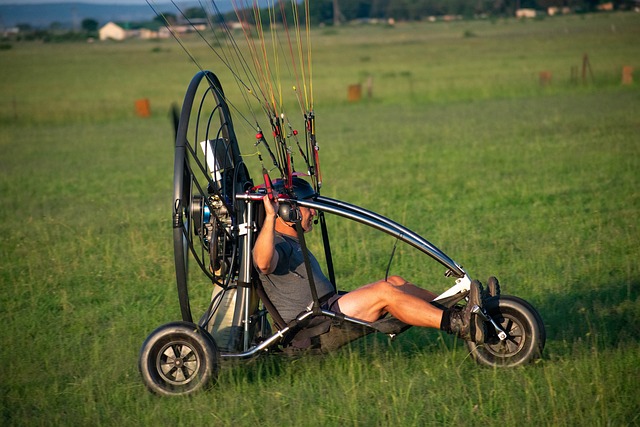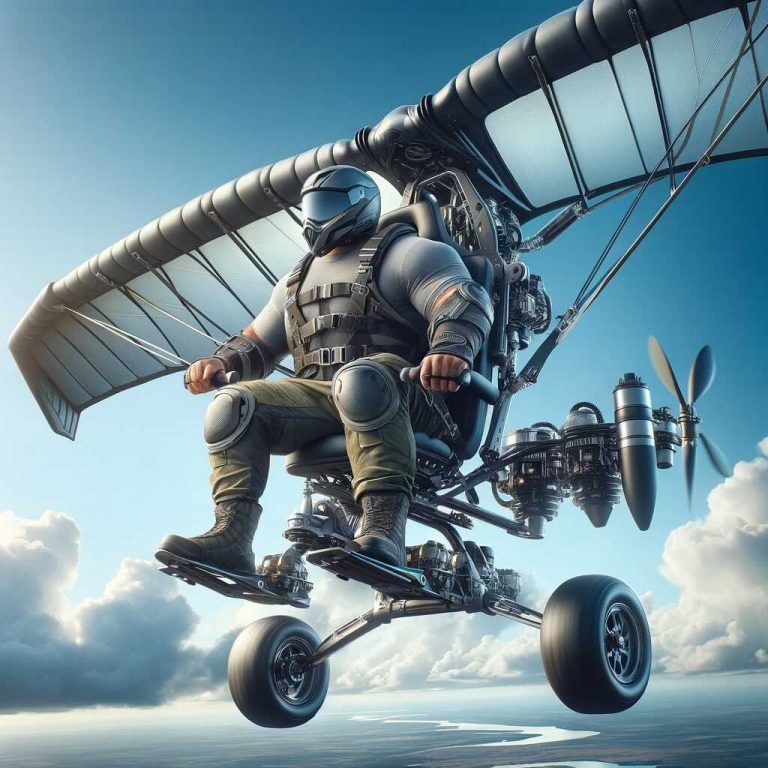The allure of flight has captivated humans for centuries, and today, paramotoring offers an accessible and exhilarating way to experience the freedom of the skies. But before you strap on a paramotor and take to the air, you may be wondering whether you need a license to fly one.
Paramotors are regulated under FAR 103, which means you don’t need a license, medical certificate, training, or registration. However, it’s essential to get proper training for a safe and enjoyable experience.
In this comprehensive guide, we’ll explore the regulations, training requirements, and essential information you need to know about paramotor licensing.
What is a Paramotor?
Before delving into the licensing requirements, it’s essential to understand what a paramotor is. A paramotor is a lightweight, powered paraglider that combines a small motor with a paragliding wing. These compact and portable aircraft offer a unique flying experience, allowing pilots to take off and land on their feet, often from open fields or even beaches. Paramotors are known for their simplicity, affordability, and the unparalleled sense of freedom they provide.
The Regulatory Landscape
The regulations governing paramotor flying can vary depending on your location, but they generally fall under the broader category of ultralight or microlight aviation. It’s crucial to research and understand the specific rules and requirements in your region, as they can significantly impact your ability to legally fly a paramotor.
United States
In the United States, paramotoring typically falls under the Federal Aviation Administration (FAA) Part 103 regulations. Part 103 governs ultralight vehicles, including paramotors. According to these regulations, paramotors are considered ultralight vehicles, and no pilot’s license is required to operate them. However, several important conditions must be met to remain within the scope of Part 103:
- Weight Limit: The aircraft, including the motor, must weigh less than 254 pounds (115 kg).
- Speed Limit: The maximum level flight speed must not exceed 55 knots (63.3 mph).
- Single Occupancy: Only one person (the pilot) can be on board.
- Daylight Operation: Flight is only allowed during daylight hours.
- No Flights Over Congested Areas: Flying over densely populated areas is prohibited.
It’s essential to emphasize that while you don’t need a pilot’s license to operate a paramotor under Part 103, you should still undergo proper training to ensure your safety and the safety of others.
United Kingdom
In the United Kingdom, the Civil Aviation Authority (CAA) oversees paramotoring and microlight aviation. Here, too, paramotors are generally considered microlight aircraft. To legally operate a paramotor in the UK, you must obtain a Private Pilot’s License (PPL) for microlights or a Powered Parachute (NPPL(M)) license, depending on the specific type of paramotor you intend to fly.
To acquire these licenses, you will need to complete the necessary flight training, pass written and practical exams, and meet the medical requirements specified by the CAA. Keep in mind that the UK’s licensing requirements are more stringent than those in the United States, so thorough training is essential.
The Importance of Training
Regardless of whether your location requires a license or not, proper training is vital when it comes to paramotoring. Operating a paramotor involves various skills, including takeoff, landing, navigation, and understanding the weather conditions that can impact your flight. Here are some reasons why training is essential:
Safety
Safety should always be your top priority when engaging in any form of aviation. Paramotoring can be deceptively simple, but it comes with its set of risks. Proper training teaches you how to handle emergencies, assess weather conditions, and make informed decisions during your flight. It also helps you understand the limitations of your equipment and how to use it safely.
Legal Compliance
Even in regions where no license is required, authorities may still expect you to have received proper training. Flying without adequate training may lead to legal consequences and could jeopardize your ability to continue enjoying this activity.
Skill Development
Paramotoring involves a unique set of skills that can only be honed through training and practice. Learning from experienced instructors will help you become a proficient and confident paramotor pilot. These skills will not only enhance your safety but also your overall enjoyment of the sport.
Equipment Familiarity
During your training, you will become intimately familiar with your paramotor equipment. Understanding how your paramotor works, as well as how to maintain and troubleshoot it, is crucial for a safe and enjoyable flying experience.
Finding the Right Training
When seeking paramotor training, it’s essential to choose a reputable and experienced instructor or school. Here are some tips to help you find the right training program:
- Research Local Options: Start by researching paramotor training programs in your area. Look for reviews, recommendations, and testimonials from previous students.
- Check Instructor Credentials: Ensure that your instructor is certified and has the necessary qualifications to provide paramotor training. They should have a solid track record of successful instruction.
- Visit the Training Facility: If possible, visit the training facility in person. Assess the condition of the equipment, the quality of instruction, and the overall professionalism of the operation.
- Ask Questions: Don’t hesitate to ask potential instructors or schools questions about their training programs, safety measures, and what you can expect during your training.
- Cost Considerations: While cost is a factor, it should not be the sole deciding factor. Invest in quality training to ensure your safety and success as a paramotor pilot.
Training Curriculum
Paramotor training programs typically consist of both ground instruction and practical flight training. Here’s an overview of what you can expect during your training:
Ground School
Ground instruction is the foundation of paramotor training. It covers essential topics such as:
- Aerodynamics: Understanding how your paramotor and wing work together.
- Meteorology: Learning to assess weather conditions for safe flight.
- Navigation: Understanding airspace, flight planning, and navigation tools.
- Safety Procedures: Pre-flight checks, emergency procedures, and risk management.
- Regulations: Familiarity with local and national aviation regulations.
Practical Flight Training
Practical flight training is where you put theory into practice. You’ll learn essential skills, including:
- Kiting: Controlling the wing on the ground to develop wing-handling skills.
- Takeoff and Landing: Proper techniques for launching and landing your paramotor.
- In-Flight Skills: Navigating, turning, and controlling your paramotor in the air.
- Emergency Procedures: Learning how to respond to unexpected situations, such as engine failures or changes in weather conditions.
Progression and Certification
Your training will typically progress through various levels of proficiency. After completing your initial training, you may earn a beginner pilot certification. As you gain experience and skills, you can work towards more advanced certifications, such as a sports pilot or instructor rating.
Safety Precautions and Gear
Safety should always be at the forefront of your mind when paramotoring. Here are some important safety precautions and gear considerations:
Helmets
Wearing a certified paramotor helmet is crucial for protecting your head in case of a fall or collision. Look for a helmet specifically designed for paramotoring, as it will offer the necessary protection without compromising comfort.
Reserve Parachute
A reserve parachute is a critical piece of safety equipment. It can be deployed in emergencies when your wing or motor malfunctions. Ensure that your reserve parachute is regularly inspected and repacked by a certified professional.
Communication
Carry a communication device, such as a two-way radio or mobile phone, to stay in touch with your ground crew or other pilots. It can be invaluable in case you need assistance or need to communicate important information during your flight.
Weather Awareness
Always check the weather conditions before your flight and throughout your flight if possible. Sudden changes in weather can pose a significant risk to paramotor pilots. If conditions deteriorate, it’s essential to have an exit plan and be prepared to land safely.
Maintenance
Regularly inspect and maintain your paramotor and wing. Preventative maintenance can help identify potential issues before they become safety hazards. Always follow the manufacturer’s maintenance guidelines.
Emergency Procedures
Be well-versed in emergency procedures and practice them regularly. This includes engine-out procedures, wing collapses, and other critical situations. Preparation can make a significant difference in your ability to respond effectively.
Where to Fly
Once you’ve completed your training and are equipped with the necessary knowledge and gear, you’re ready to take to the skies. However, it’s essential to choose your flying locations wisely. Here are some tips on where to fly your paramotor:
Legal Considerations
Ensure that you fly in areas where paramotoring is permitted and follow all local aviation regulations. Flying in restricted or prohibited airspace can lead to legal consequences and put your safety at risk.
Open Spaces
Paramotors are well-suited for flying in open spaces such as fields, beaches, or designated flying areas. These locations provide ample room for takeoff, landing, and maneuvering.
Avoid Crowded Areas
Steer clear of densely populated areas, roads, and buildings. Flying low over people, vehicles, or structures can be dangerous and may violate regulations.
Altitude and Airspace
Be aware of the altitude limits and airspace restrictions in your area. Flying too high or into controlled airspace without authorization can lead to safety risks and legal issues.
Weather Conditions
Pay close attention to weather conditions before and during your flight. Avoid flying in turbulent or adverse weather, as it can affect your safety and the handling of your paramotor.
Conclusion
Paramotoring offers a thrilling and accessible way to experience the joys of flight. While licensing requirements vary by location, the importance of proper training cannot be overstated. Safety should always be your top priority, and investing in quality training will ensure that you can enjoy this exhilarating sport to its fullest.
Whether you’re soaring over picturesque landscapes or exploring new horizons, paramotoring can be a transformative experience. As you embark on your paramotoring journey, remember the importance of responsible flying, continuous learning, and adherence to safety measures. By doing so, you can unlock the true magic of paramotoring while keeping yourself and others safe in the skies.








